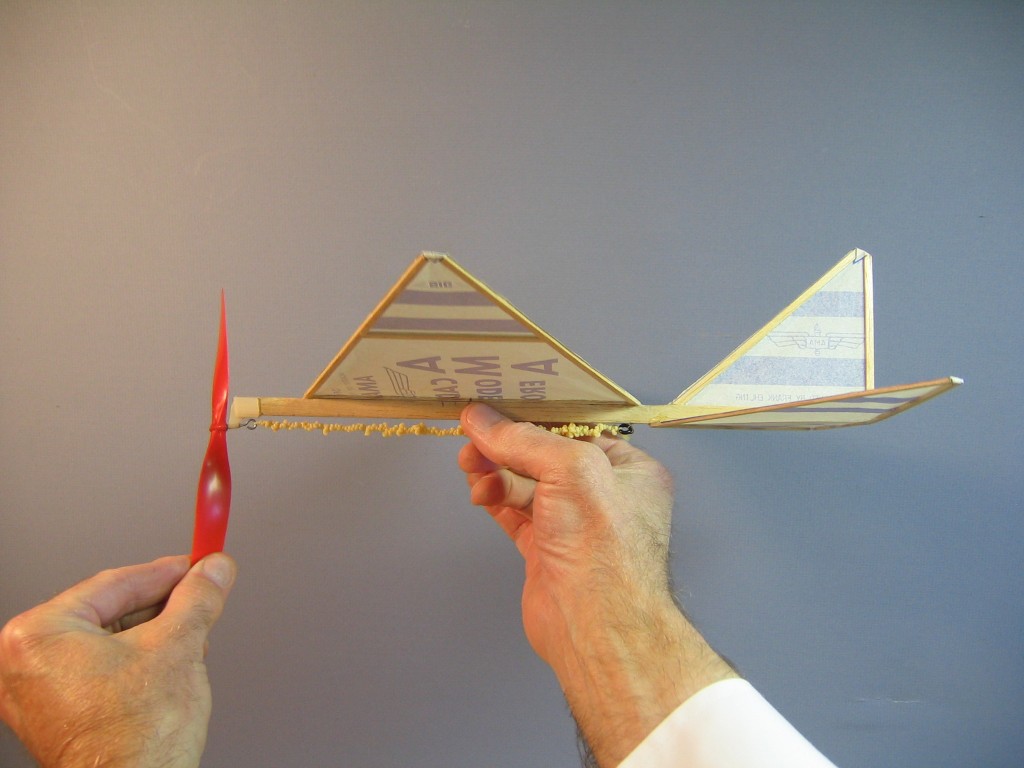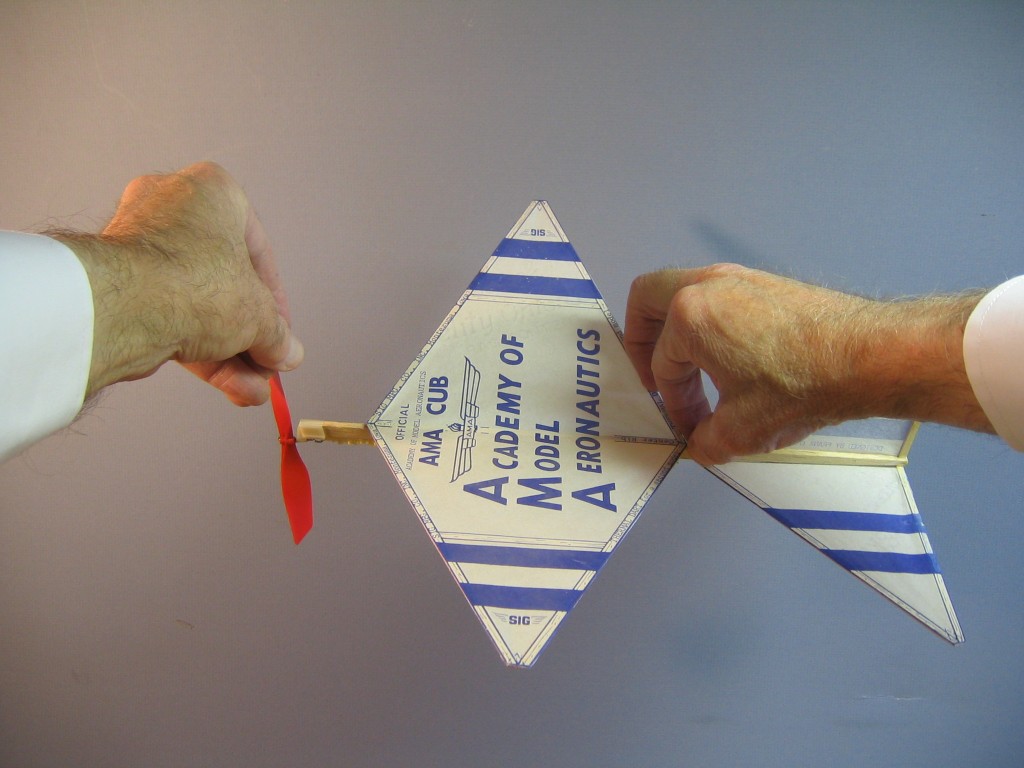AMA Cub Teaching Notes
Launching the Plane for Its First Test Flights
At this point, the planes have been built and the motor has been wound on one. One plane at a time is flown. Wait for any flying planes to land and be removed from the floor. No one is out on the floor except the flyer and teacher. This is to prevent damage to the planes. The other students should be close enough to hear and watch the teaching. The teacher may want to demonstrate first, or you can proceed directly with the first student.
There are three levels of launching; standing, kneeling and from the floor. We will start with the standing position because the first flights will not go high enough to approach the ceiling and it is easiest. Once the skills of a standing launch have been mastered, kneeling launches are easy. Floor level launches are a little different and require more skill.
Show the student how to hold the plane for launch. The right hand grips the stick below the mid point of the wing. Always hold the plane by the motor stick. It is the strongest part of the plane. Picking it up by the wings, tail or fin risks damaging the plane. The left hand grips the tip of the prop from below. Hold the plane at a comfortable height that allows theslight arm movement of launching. You can hold it at about ear height, or over your head.
The plane is expected to fly in a left circle. Hold the plane with the wound motor by the propeller and let the plane turn freely. Point out that the plane rotates to its left, into a left bank. Point the tail of the plane toward the students so they can see the plane rolling to the left. That is because of the motor torque acting on the rear motor hook. Now walk along with the nose of the plane pointing slightly to the right of the direction of movement. The relative wind will be caught under the left wing and the plane will stop rotating. In flight, the motor torque rolls the plane into a left bank. A left bank makes the plane sideslip to the left. The plane then meets the oncoming air under its left wing. The air coming from the left produces a right roll. A properly designed plane will find a balance between the torque of the motor and the roll due to the wing dihedral. Because the lift is now tilted slightly to the left, the lift will pull the plane into a left circle.
The purpose of the first test flights is to check trim and circle. We want to make sure the plane does not zoom up and stall, does not dive into the floor, does not bank too steeply and sideslip into the floor, does not turn too tightly and does not turn so wide that it hits the wall. Tell the student to watch the plane and note its flight pattern. Note how fast it moves, which way it turns, how much it banks, how tightly it turns and whether it goes up or down.
A pilot must have a flight plan to fly a plane safely. Many people will stand with their back to the wall and launch the plane out into the room. The plane will circle back and hit the wall. For the plane to fly in a circle within the walls of a room, the center of the flight circle must be in the center of the room. That means the plane must be launched somewhere on the perimeter of the flight circle, pointing along the flight path in the direction of flight. Imagine the flight circle within the room with the center near the center of the room. Stand near the center of the long wall with the left shoulder pointing to the center of the room. Point the plane straight ahead, parallel with the wall, holding it as instructed above. Hold the plane off the right shoulder, about head high or higher, with the nose pointed up slightly. Hold the plane back as far as comfortable. Move the arms forward while taking a step forward, to get the plane up to flying speed. Release the prop and immediately give the plane a gentle push. Drop the left hand from the prop to avoid the wings or tail hitting it and spoiling the flight. A hard throw will make the plane zoom up and stall. A slow launch may result in the plane hitting and bouncing along the floor. You want to release the plane at flight speed and in flying attitude. The prop and motor will take over from there.
Once the plane has shown that it can fly a smoothe circle or two overhead, you can increase the number of turns you put into the motor. Add another 100 turns and try another flight. Keep adding 100 turns until it gets close to the ceiling, then try adding 50 or 25 turns. If it hits the ceiling, back off half the last number you added, until the plane flies as closely to the ceiling as possible, making smaller and smaller adjustments to the number of turns with each flight. The goal is to get the longest flight possible. Time your best times with a stopwatch. When you have the best flight time you can get, record the number of turns used. Now you are ready to fly in the AMA Cub contest.
The kneeling launch is done in very much the same way as the standing launch. You hold the plane the same way, but it is not easy to take a step, so you use more arm and upper body movement. The kneeling launch gives the plane more vertical space to fly in, making it possible to get longer flights. That is an advantage in contests.
The floor launch is done from a kneeling position, but bent over at the waist. The plane is held from above. The right hand holds the motor stick behind the wing. The left hand holds the tip of the prop from above the plane. Rock to the right, extending your arms to the right, then rock quickly to the left and swing your arms to the left, releasing the prop, then immediately relasing the plane with a push. Pull your left hand up after releasing the prop to avoid it catching the fin. The floor launch requires more practice and skill to get the plane smoothly into the air at flying speed. The plane is more likely to hit the floor. The advantage is that launching as close to the floor as possible allows you to use the maximum possible amount of vertical room under the ceiling. The time that can be added to your flight compared to what you get with a standing launch is the time it takes for the plane to climb from the floor to shoulder height plus the time it takes to descend from shoulder height to the floor. You will use a few more turns on the motor for the floor launch compared to the shoulder launch.
The next lesson will talk about interpreting the flight observations and making any necessary adjustments.

